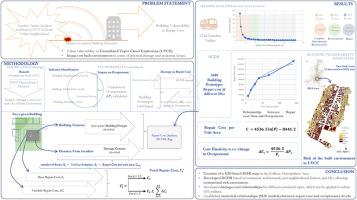Risk assessment and loss estimation of urban built environments exposed to UVCE from off-site gasoline transport incidents
IF 4.2
3区 工程技术
Q2 ENGINEERING, CHEMICAL
Journal of Loss Prevention in The Process Industries
Pub Date : 2025-09-02
DOI:10.1016/j.jlp.2025.105780
引用次数: 0
Abstract
The increasing gasoline consumption in India has led to a surge in off-site gasoline transportation, heightening the risk of spills triggering Unconfined Vapor Cloud Explosions (UVCE). Such incidents pose significant threats to the built environment, particularly in densely populated urban corridors. This study presents a systematic framework for assessing the physical vulnerability of urban structures to UVCE, employing a building prototype-based approach. The methodology integrates macro and micro-level assessments, considering building and neighborhood characteristics, structural integrity, and exposure levels to quantify potential damage. A deterministic blast overpressure analysis is conducted using the TNT equivalency method, mapping damage levels to building structures. The study employs an indicator-based approach to capture the effects of neighborhood configurations, architectural design, and structural attributes of buildings on blast overpressure which in turn alter the building damage. By defining standardized building prototypes, the framework estimates repair costs as a proxy for vulnerability, offering a detailed spatial assessment of at-risk areas. The model is applied to a high-density urban corridor in the Kolkata Metropolitan Area (KMA), where 1,979 buildings are surveyed, classified, and analyzed under a worst-case scenario, providing spatially visualized risk assessments. Findings reveal that neighborhood characteristics, architectural configurations, and structural integrity significantly influence vulnerability, highlighting high-risk zones requiring targeted interventions. The study underscores the need to integrate safety considerations into urban planning, infrastructure resilience, and emergency response strategies. By bridging risk assessment with urban development, this research provides policymakers, engineers, and emergency planners with actionable insights to mitigate UVCE risks in rapidly urbanizing environments.

非现场汽油运输事故中UVCE暴露的城市建筑环境的风险评估和损失估计
印度不断增长的汽油消费量导致了非现场汽油运输的激增,增加了引发无限蒸汽云爆炸(UVCE)的泄漏风险。这类事件对建筑环境构成重大威胁,特别是在人口密集的城市走廊。本研究提出了一个系统的框架来评估城市结构对UVCE的物理脆弱性,采用基于建筑原型的方法。该方法综合了宏观和微观层面的评估,考虑了建筑和社区特征、结构完整性和暴露水平,以量化潜在的损害。采用TNT当量法进行了确定性爆炸超压分析,绘制了建筑结构的损伤等级。该研究采用了一种基于指标的方法来捕捉社区配置、建筑设计和建筑物结构属性对爆炸超压的影响,而爆炸超压反过来又改变了建筑物的损坏。通过定义标准化的建筑原型,该框架估计修复成本作为脆弱性的代理,提供风险区域的详细空间评估。该模型应用于加尔各答大都市区(KMA)的高密度城市走廊,在最坏情况下对1979栋建筑进行了调查、分类和分析,提供了空间可视化的风险评估。研究结果表明,社区特征、建筑配置和结构完整性显著影响脆弱性,突出了需要有针对性干预的高风险区域。该研究强调了将安全考虑纳入城市规划、基础设施复原力和应急响应战略的必要性。通过将风险评估与城市发展联系起来,本研究为政策制定者、工程师和应急规划人员提供了可操作的见解,以减轻快速城市化环境中的UVCE风险。
本文章由计算机程序翻译,如有差异,请以英文原文为准。
求助全文
约1分钟内获得全文
求助全文
来源期刊
CiteScore
7.20
自引率
14.30%
发文量
226
审稿时长
52 days
期刊介绍:
The broad scope of the journal is process safety. Process safety is defined as the prevention and mitigation of process-related injuries and damage arising from process incidents involving fire, explosion and toxic release. Such undesired events occur in the process industries during the use, storage, manufacture, handling, and transportation of highly hazardous chemicals.

 求助内容:
求助内容: 应助结果提醒方式:
应助结果提醒方式:


